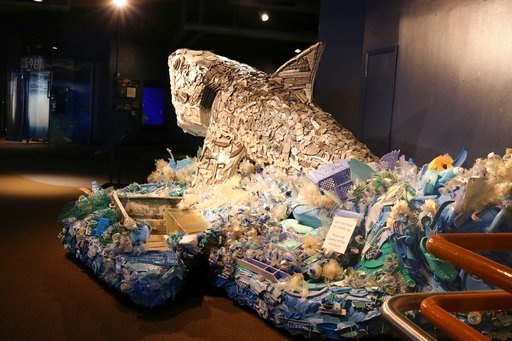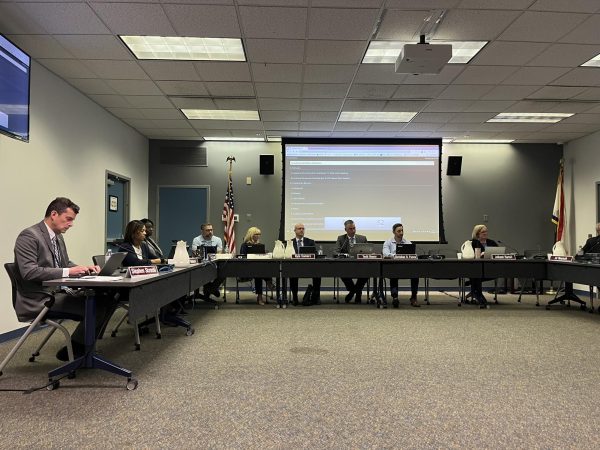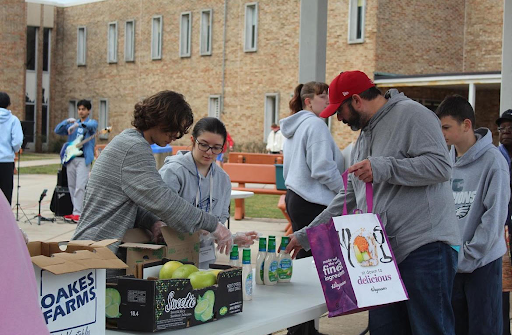Saving the planet, one change at a time

In this photo taken July 26, 2018, a section of a boat that washed ashore is incorporated into the sculpture of “Greta the Great White Shark,” one of six sculptures made out of ocean trash as part of a project called “Washed Ashore: Art to Save the Sea” at the Audubon Aquarium of the Americas in New Orleans. (AP Photo/Janet McConnaughey)
Have you ever wondered where trash goes after you throw it away? Perhaps you think it’s finally gone and out of your life, or that it’s being recycled.
Well, you’re wrong.
Over 90% of plastic isn’t recycled and ends up in landfills. It then takes over 450 years to decompose. But during that time, plastic waste ends up in the oceans where it is consumed by sea life and can most likely end up in our food chain. This is a problem because plastic contains toxins like Bisphenol-A (BPA) which disrupts hormones and may cause cancer. In addition to that, it could also absorb more toxins found in the oceans.
So in reality, trash is never completely gone out of our lives.
Since 1950, we have produced over 8.3 billion metric tons of plastic. Most of which are still sitting in landfills today or are laying in gyres, areas of spinning debris in the ocean. The top 5 collected trash items found on our beaches were cigarette butts with plastic filters (2.4 million), food wrappers (1.7 million pieces), plastic beverage bottles (1.6 million), plastic bottle caps (1.1 million), and plastic grocery bags (757,523). Most of the trash we create is single-use plastics, or disposables, which has become a huge problem throughout the years as we continue to use them due to their convenience.
We live in a world literally made up of plastic. It may not seem like a problem to most of us but it can leave a long lasting effect on our future. In 2050, there will be more plastic than fish in the ocean. By then, experts claim that we’ll be producing three times as much plastic as we do now. But by that point, plastic made since 1950 will still have hundreds of years left to decompose.
So, how do we fix this problem?
I know not everyone can become “zero waste,” a recent popular movement, since it is inconvenient in many cases. But that shouldn’t stop you from trying to be more eco-friendly. Recently, San Francisco has banned the use of plastic straws. To some, it may sound unnecessary, but it’s a step that will lead to big changes. If everyone made small changes in their daily life to help the environment, imagine how it would affect our planet.
Saving the environment shouldn’t be this hard, so here’s a list of alternatives to your daily routine:
1. Use reusable bags: This is by far the easiest switch you can make. You can also get some change back if you bring your own bag to various stores.
2. Bring your own water bottle: Preferably a stainless steel bottle instead of reusable plastic ones because the plastic contains toxins that can enter your water when exposed to the sun/heat.
3. Switch out your disposable/plastic razors for safety razors: It may seem terrifying, but it works the same way. The prices of regular razors are extremely high and you constantly have to spend money getting new blades and sometimes a razor. The prices of safety razors can be expensive but you only buy them once and they last you a lifetime. You could also buy a pack of 100 blades for around $10 on Amazon. Just think about how much money you could save in the long run.
4. Refuse straws or invest in reusable ones: Straws are completely unnecessary to use, but if you really need to use one, there are so many options out there.
5. Stop buying products with microbeads: Not only are they bad for the environment, but they’re horrible for your skin. The plastic beads cause you to over exfoliate by creating small tears in your skin leading to more acne. Why waste money on something that only makes matters worse? Instead, try buying ones that dissolve, or make your own!
6. Switch out cling wraps for reusable wax wraps: Reusable wax wraps can last up to a year while regular cling wraps can only be used once.
7. Replace your plastic toothbrush with a bamboo toothbrush: A bamboo toothbrush is biodegradable and will have a better impact on the environment.
8. (For females) Try using a diva cup or any menstrual cup instead of single-use period products: It saves so much money and reduces almost all the waste you create while on your period.
9. Use unpackaged soap bars instead of liquid soap in plastic bottles when washing your hands: At the end of the day, all soaps have the same purpose. The only difference is that liquid soap has added fragrance that doesn’t really do much other than making your hands smell nice so they seem cleaner.
10. Buy things in bulk: For many places, it may be difficult to find specific stores where you could buy everything in bulk. But if you’re able to buy at least some things in bulk, it’s so much better than not making an effort at all.
For years, we relied on recycling to solve our problem with trash. But that needs to change. Instead, we should focus more on reducing our waste first. By doing that, we wouldn’t have to worry about where our trash goes in the first place. If we don’t make an effort to save the environment, things will only get worse.
Our planet has given us resources that have benefited us for a millennium. So why do we destroy the planet in return? Change is important even if it makes the slightest difference. If we make changes now, imagine how much better the planet will be in our future. We were the ones who created this mess, now it’s our time to fix it.
Sources Used:
https://ecologycenter.org/plastics/
https://www.ecowatch.com/beach-litter-plastics-ocean-conservancy-2581760475.html
https://psmag.com/environment/could-that-plastic-in-your-trash-be-hazardous-54252
https://www.vox.com/the-goods/2018/9/19/17800654/clothes-plastic-pollution-polyester-washing-machine
https://www.nationalgeographic.com/magazine/2018/06/the-journey-of-plastic-around-the-globe/
https://www.nationalgeographic.com/magazine/2018/06/plastic-planet-waste-pollution-trash-crisis/










